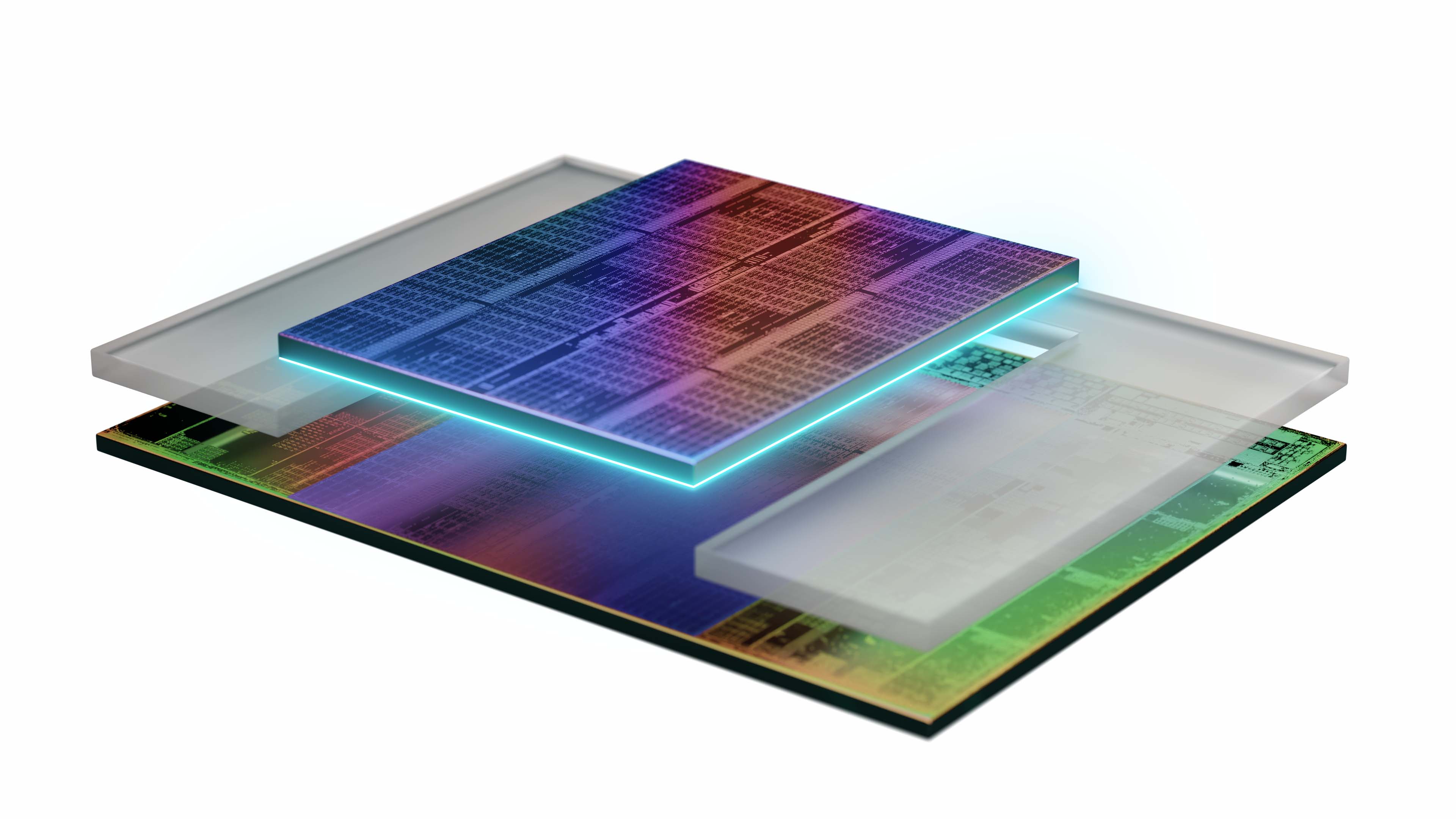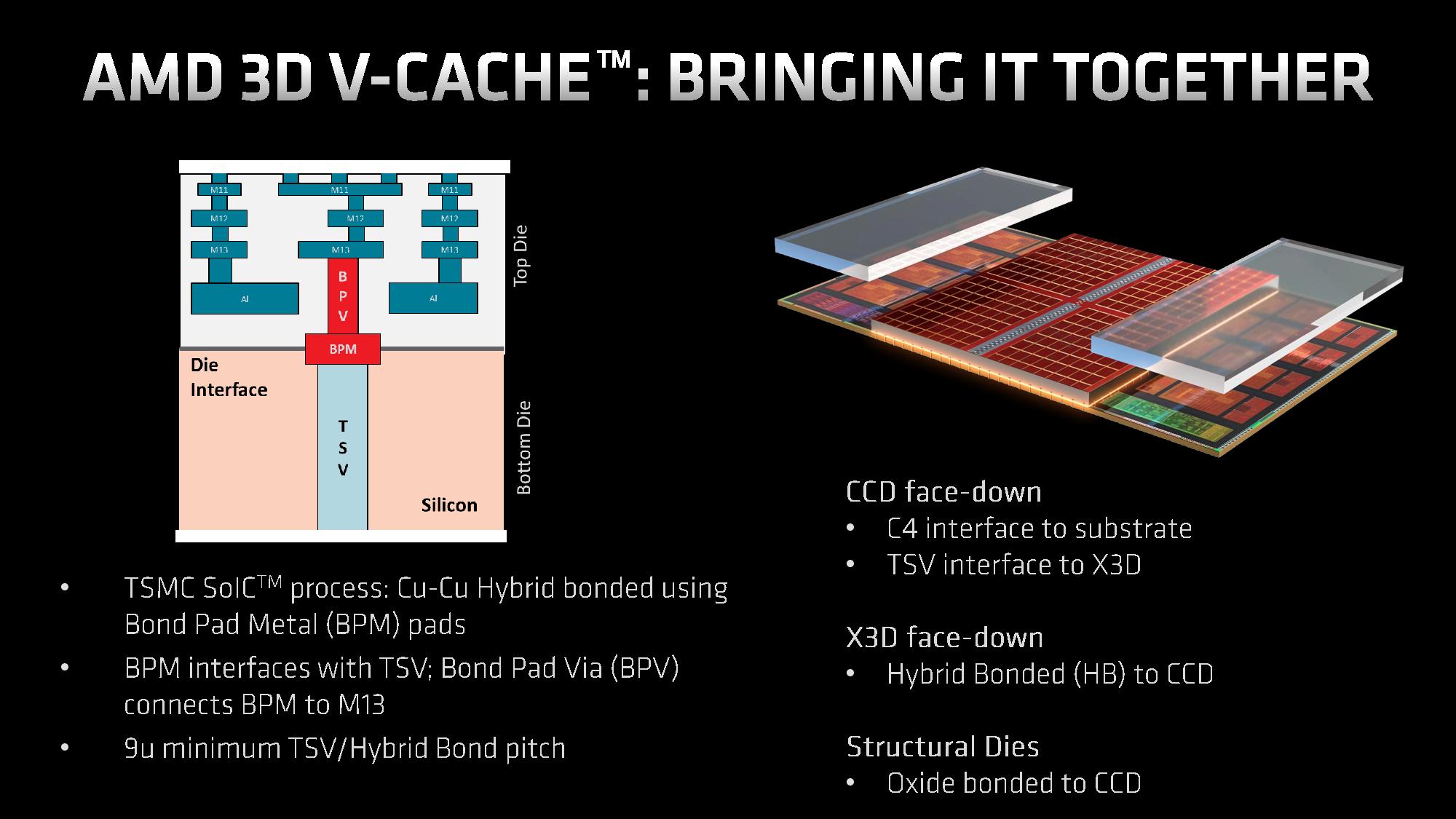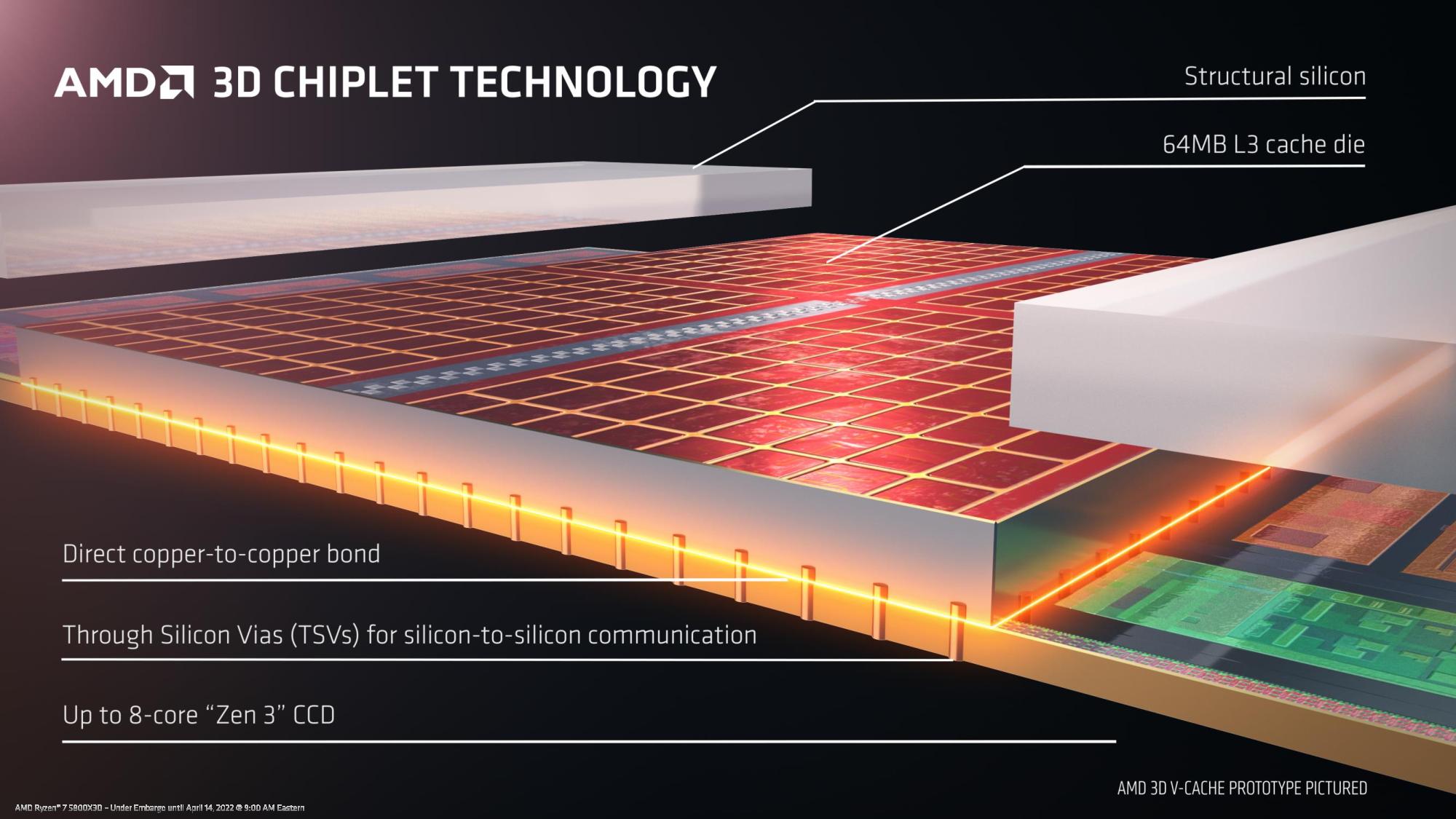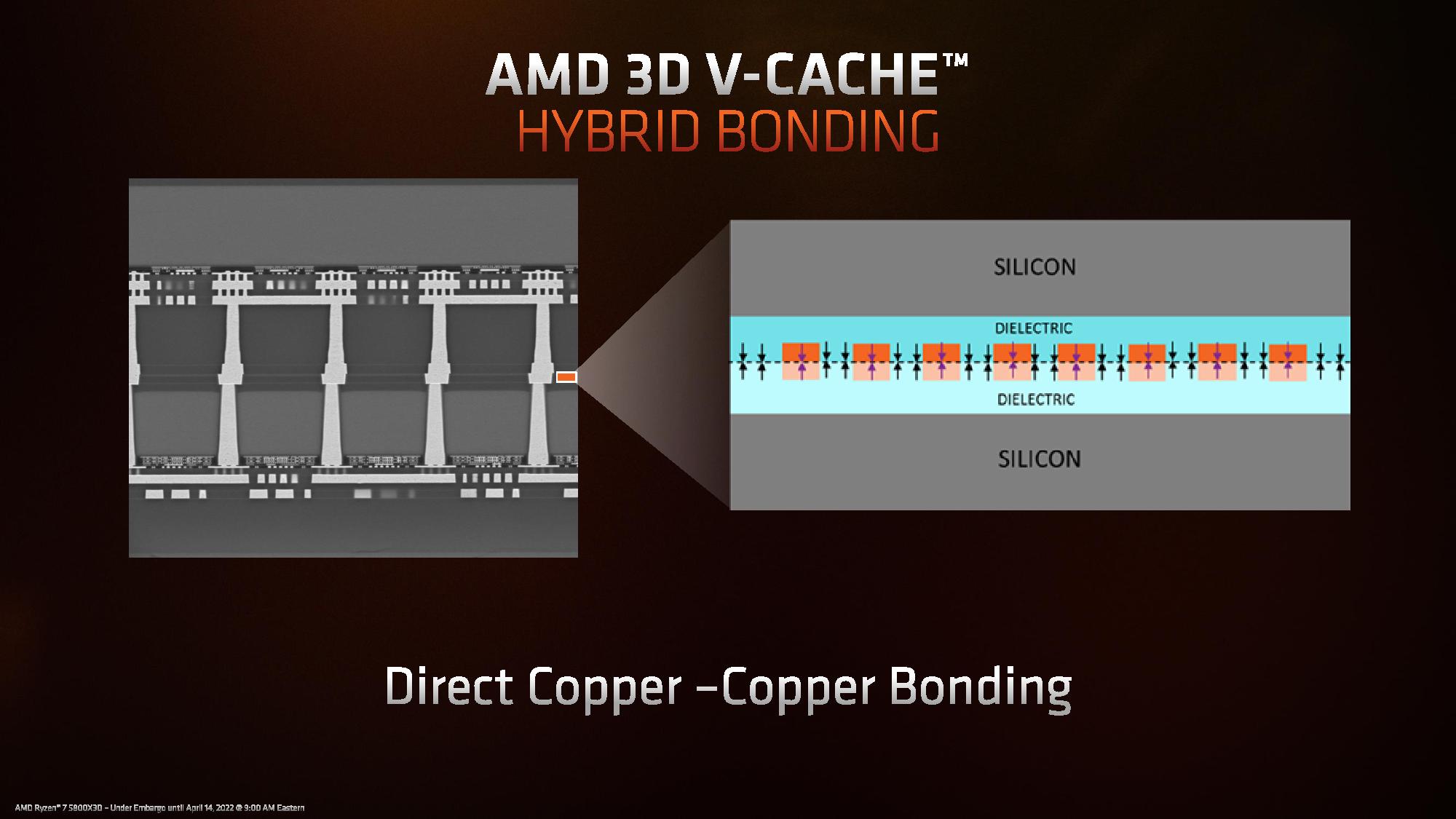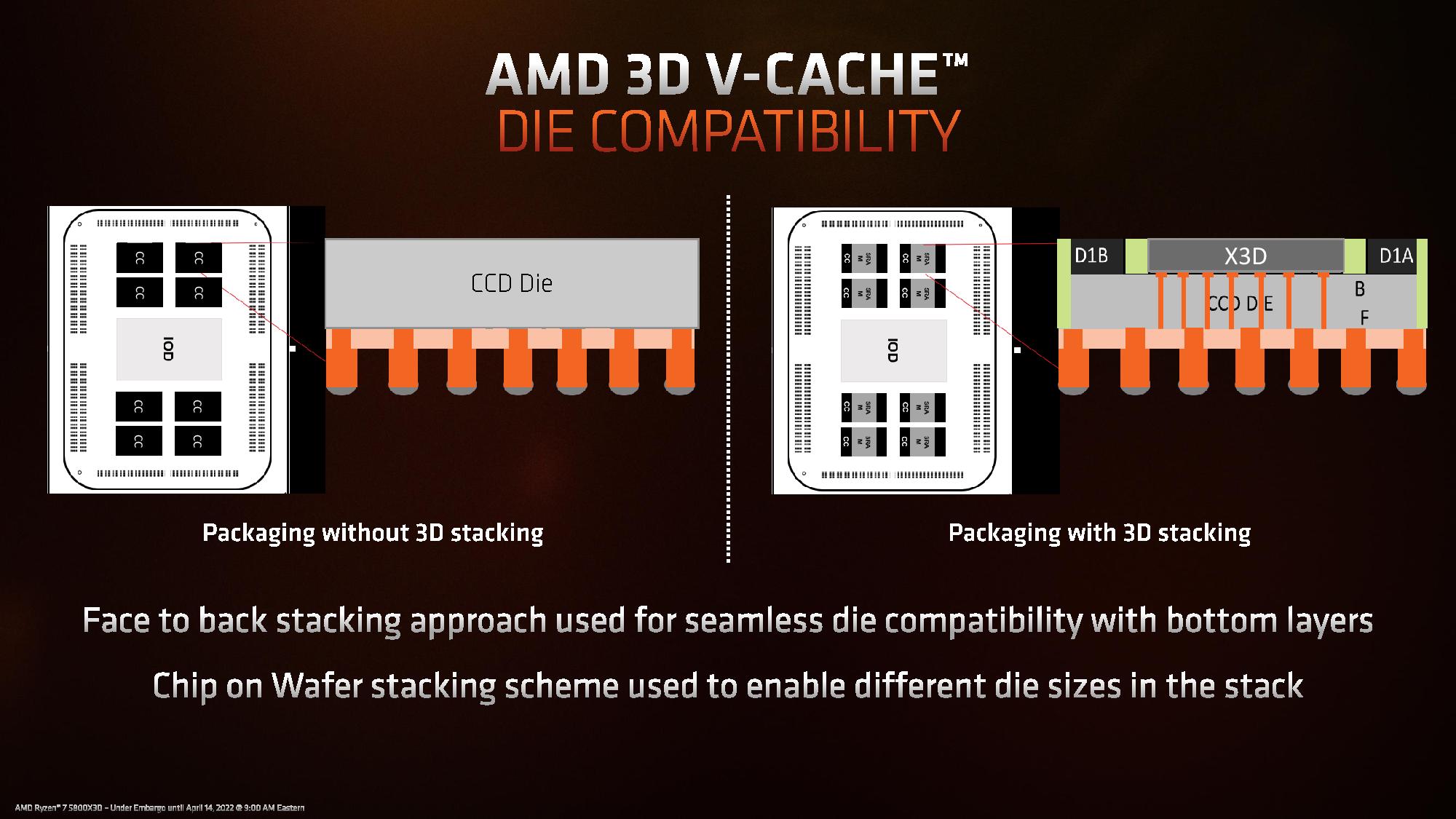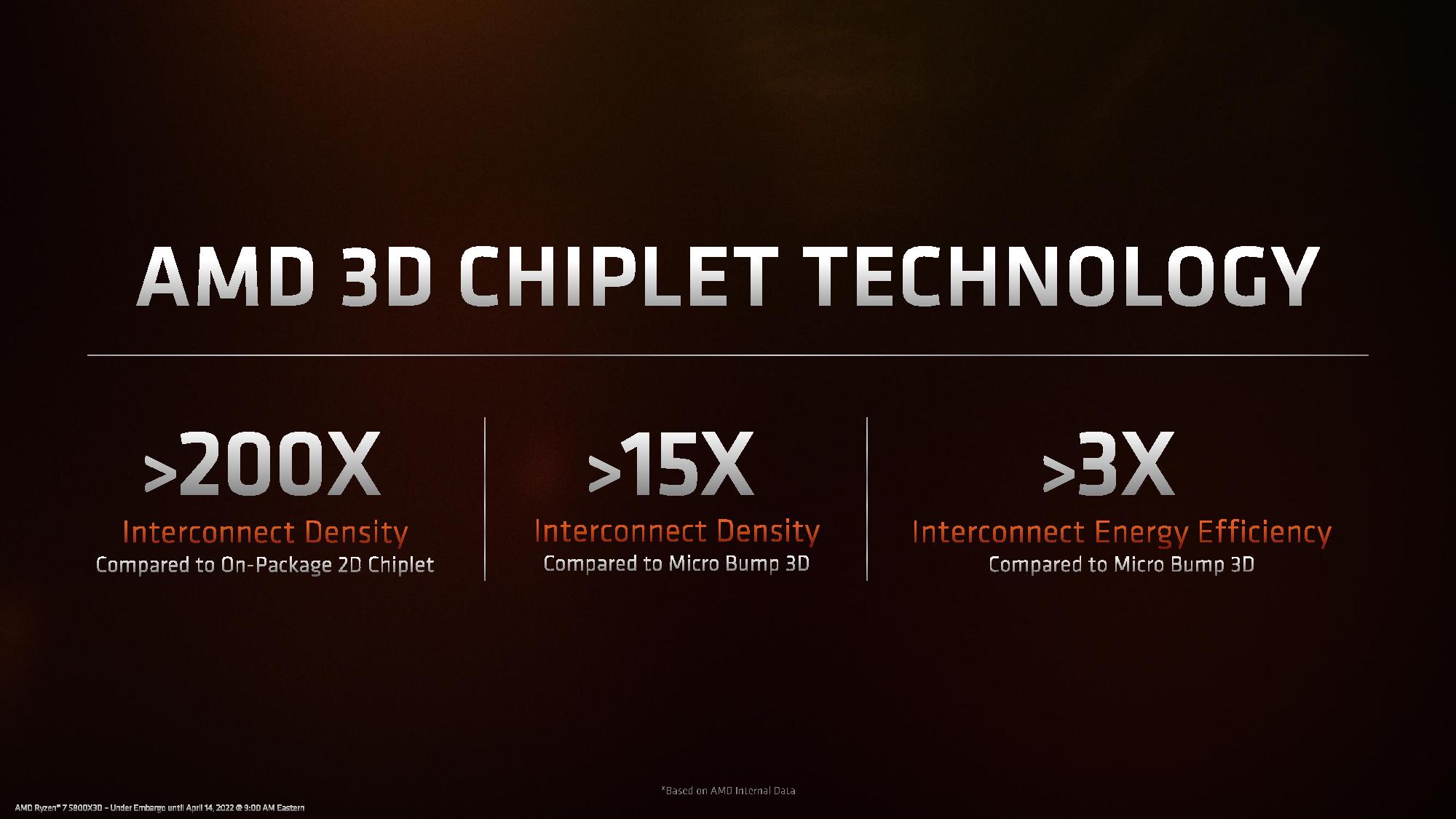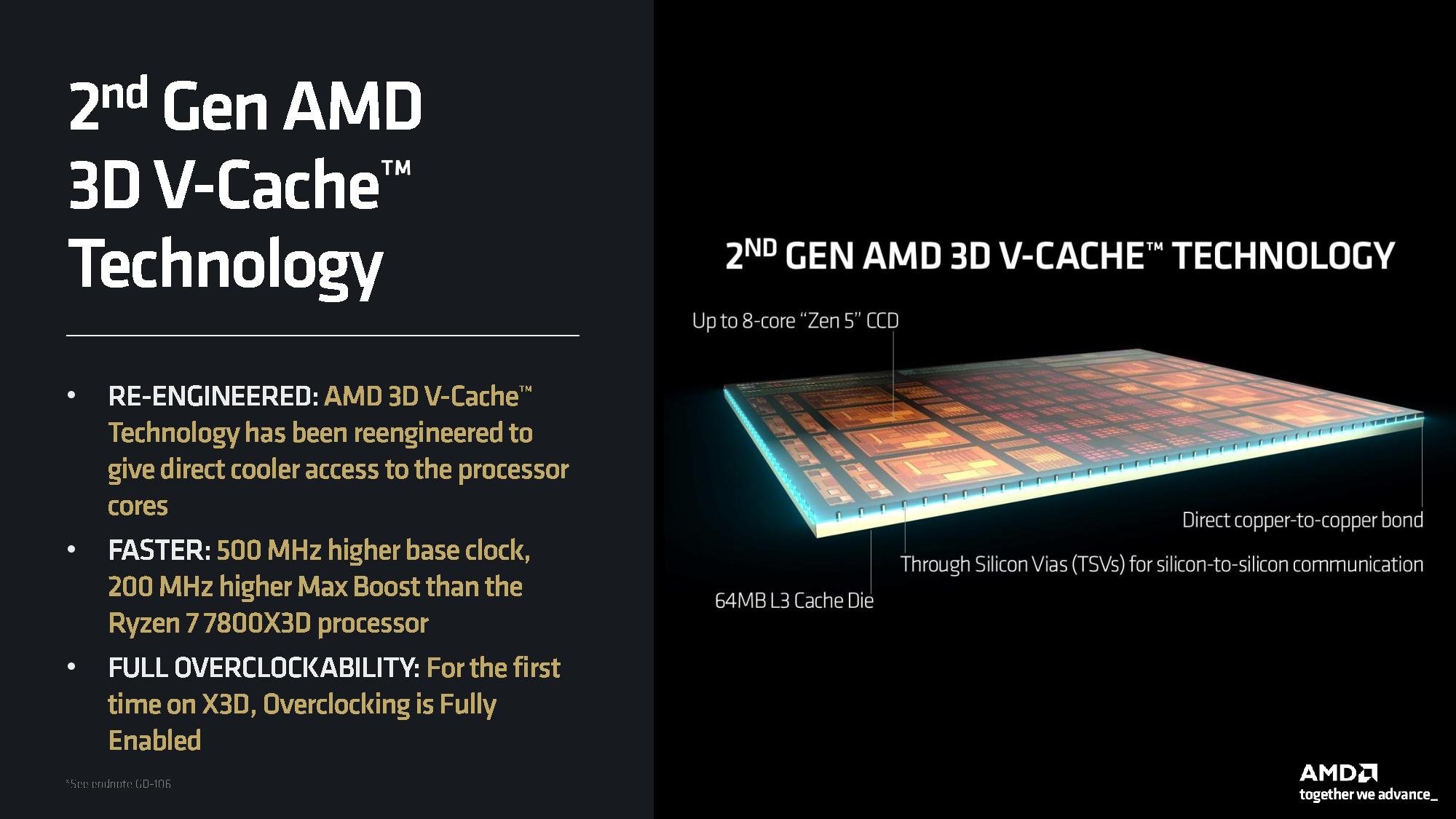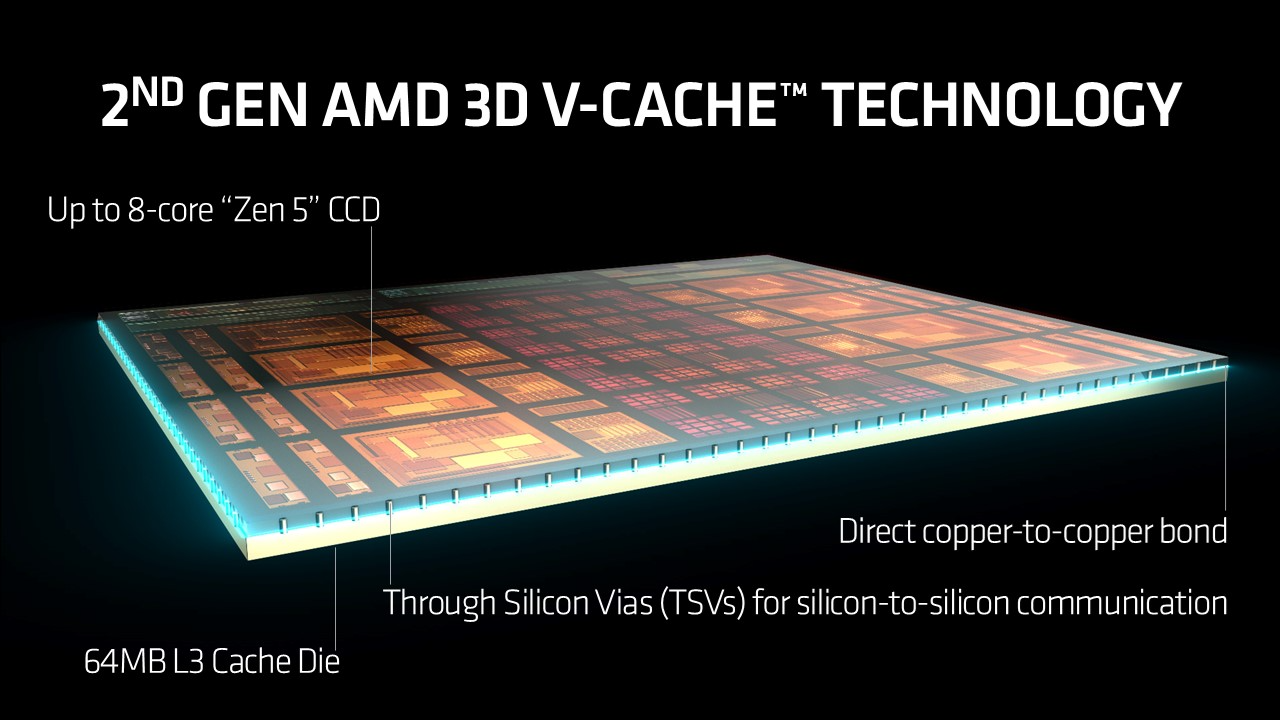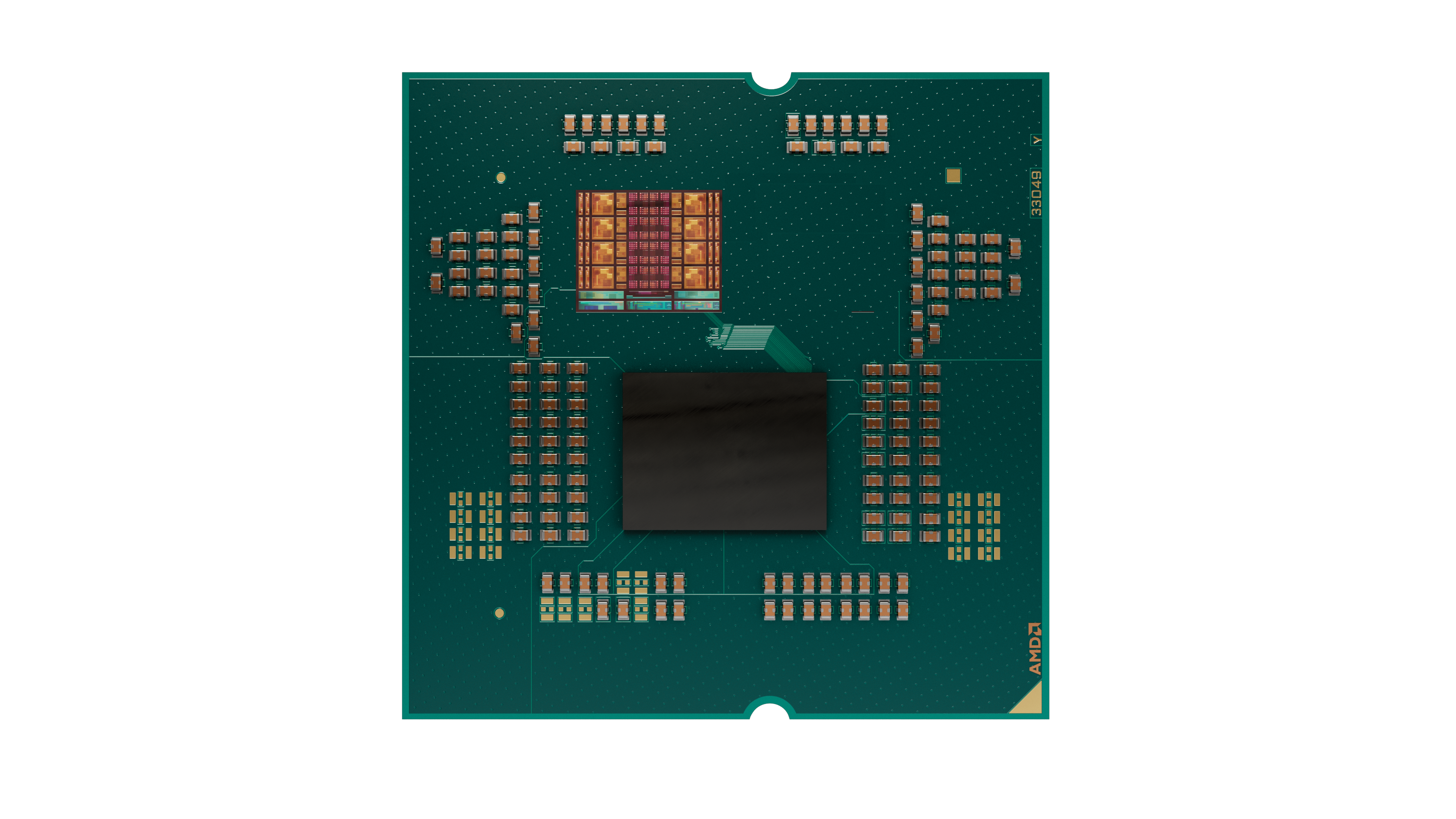AMD’s $480 Ryzen 7 9800X3D comes armed with eight cores and 16 threads paired with a new version of the company’s game-boosting 3D V-Cache tech that delivers impressive performance, taking the throne as the fastest gaming CPU on the market in convincing fashion. AMD claims the chip is 20% better than Intel’s latest flagship and 8% faster than the prior-gen Ryzen 7 7800X3D. However, our benchmarks show it beats Intel’s current-gen flagship Core 9 285K by an almost unrealistic 35% on average in our test suite. It even beats Intel’s fastest competing gaming chip, the Core i9-14900K, by an equally incredible 30% on average in our test suite. Naturally, the gains will vary by title due to the vagaries of the 3D V-Cache tech. Still, we recorded incredible performance that firmly cements the Ryzen 9 9800X3D as the best CPU for gaming.
AMD accomplished this feat by leveraging its tried-and-true 3D V-Cache technology, which uses a beefy, vertically-stacked 64MB L3 cache chiplet to boost gaming performance. To improve performance further, AMD moved the cache chiplet from the top of the processor to the bottom. This yields substantially higher thermal headroom, enabling higher clock rates while the additional cache unlocks the Zen 5 architecture’s peak gaming performance. As we’re accustomed to with gaming-optimized X3D processors, not all games will benefit from the tech, and a few are even slightly slower (1 to 2%) than the previous-gen model. Still, the chip also vastly improves 1% low frame rates even in those titles. The higher 1% lows will also help when you’re GPU-limited, like when gaming with higher resolutions.
AMD has also now enabled full overclocking for the 9800X3D, which we’ve put to the test, allowing you to scrape out more performance in both gaming and productivity work. Speaking of which, the new design also helps to remove some of the heavy penalties in productivity work that you’ll often pay for using a gaming-optimized X3D processor, allowing the 9800X3D to match, and at times even exceed, a comparable eight-core Ryzen 9000 CPU in several productivity workloads.
The $480 Ryzen 9 9800X3D is AMD’s lone chip launch today, and the chip will be available on shelves tomorrow. The 9800X3D saves the day for gaming enthusiasts faced with not just one, but two disappointing chip launches this year: AMD’s Zen 5-powered Ryzen 9000 series debuted with lackluster gaming performance gains when it arrived earlier this year, but as you’ll see in our fresh testing we did for this review, recent firmwares and a Windows tweak have wrung out more performance. Intel also released its highly anticipated Arrow Lake Core Ultra series just two weeks ago, but those chips failed to match the gaming performance of Intel’s prior-gen chips. Unfortunately, there’s no evident fix in sight, which set the stage for a disappointing coming year for gaming chips.
The Ryzen 7 9800X3D changes that completely, bringing a top-tier gaming chip to market at a reasonable price point given its capabilities. The chip drops into existing AM5 motherboards and won’t require the pricey complementary components, like the pricey high-speed RAM kits, beefy coolers, and motherboards needed to extract the utmost performance from other top-tier chips. Meanwhile, Intel seems wholly unable to counter AMD’s 3D V-Cache tech even after two and a half long years, and now three chip generations, after it debuted with the now-legendary Ryzen 7 5800X3D. Let’s look at the tech, then move on to the surprisingly good gaming benchmarks.
AMD Ryzen 7 9800X3D Pricing and Specifications
The Ryzen 7 9800X3D features the Zen 5 microarchitecture, which you can read more about here. The processor is compatible with AM5 motherboards, and AMD’s partners finally have X870E models available on the market.
The eight-core, 16-thread Ryzen 7 9800X3D debuts at $480, a $30 premium over the launch pricing of the Ryzen 7 7800X3D. The 9800X3D has a 120W TDP and features 500 MHz higher base clocks and 200 MHz higher boosts than the previous-gen Zen 4-powered Ryzen 7 7800X3D.
The 9800X3D’s 5.2 GHz boost is impressive, but that lags the direct Zen 5 comparable, the eight-core Ryzen 7 9700X, by 300 MHz. However, AMD has compensated with a 900 MHz higher base clock, allowing the 9800X3D to outpace the 9700X in some threaded workloads, as you’ll see in our benchmarks on the following pages.
As with the prior-gen models, the Ryzen 7 9800X3D doesn’t come with a cooler. AMD recommends a 240-280mm liquid (or equivalent) cooler. The processor has the same 95C maximum temperature (TjMax), but the new L3 cache chiplet design allows the chip to operate at higher clock rates for longer periods of time (enhanced boost residency), which equates to stronger performance gains within the same TDP envelope.
The Ryzen 7 9800X3D is fully overclockable — you can tune the CPU cores, fabrics, and memory to your liking. However, while multiplier-based overclocking is available, as we’ve seen with other Zen 5 processors, most users with conventional cooling will be best served using the auto-overclocking Precision Boost Overdrive (PBO) feature. We have extensive testing with this feature enabled on the following pages.
AMD also bumped memory support up to DDR5-5600 from the DDR5-5200 found with the previous-gen 7800X3D.
AMD Ryzen 7 9800X3D architecture
In the illustrations above, you can see AMD’s original approach with its 3D V-Cache tech. With previous designs that leveraged the Zen 3 and Zen 4 architectures, AMD stacked an additional L3 SRAM chiplet directly in the center of the compute die (CCD) chiplet to isolate it from the heat-generating cores. We’ve covered the details of the first generation of this technology here.
AMD used hybrid bonding technology to join the cache chiplet to the underlying compute die. This boosted cache capacity to 96MB to accelerate performance in latency-sensitive applications, like gaming.
AMD placed the chiplet and several pieces of structural silicon on top of the compute die, but as we demonstrated with thermal throttling tests of the Ryzen 9 7950X3D processor, the cache chiplet and structural silicon shims served as a thermal blanket that hampered effective thermal transfer, essentially trapping waste heat. As a result, AMD limited the effective voltage and frequency range of the 3D V-Cache-equipped die to rein in heat generation. Simply put, the chip ran hot, and thus had to run slower.
AMD has now placed the cache chiplet underneath the die to alleviate the thermal challenges, thus placing the compute die closer to the thermal interface material, IHS, and eventually the CPU cooler. This improves the amount of compute performance AMD can extract from the 120W TDP envelope, and it also improves boost residency/duration. However, it comes with a new set of challenges — this design requires AMD to route the power and signal TSVs for the entire chip through the underlying L3 cache chiplet.
The new L3 cache chiplet is based on the same 7nm SRAM-optimized process node that AMD used in the previous two generations of 3D V-Cache technology in a technique that AMD now refers to as its ‘Second-Gen 3D V-Cache’ technology (this is an odd branding choice — this is actually the third refinement of the technology).
As before, AMD thins both the L3 cache chiplet and the 4nm (N4P) compute die to adhere to the standard Z-Height requirements for the processor package. AMD uses the same hybrid copper-to-copper bonding with a 9-micron bump pitch to join the two die.
The chiplet now spans the entire bottom of the compute die, thus eliminating the need for the structural silicon shims. AMD isn’t sharing the size of the L3 cache chiplet or the transistor density, but the compute die measures 70.6 mm^2, so it’s safe to bet that’s also the size of the cache chiplet. That’s much larger than the 36 mm^2 L3 cache chiplet used for the Zen 4 X3D models — this is despite the use of the same process node and the same 64MB of L3 capacity.
Naturally, AMD has to feed more power and signal TSVs through the L3 cache chiplet, which now serves as an interposer of sorts, up to the compute die. AMD says that power TSVs are distributed throughout the SRAM die to feed the compute die that resides above. Extra power TSVs are distributed in areas that are unused for other functionality (presumably as more cache storage), which should at least partially account for the larger size.
AMD says accesses to the L3 cache chiplet incur the same four-clock penalty as with the prior generation. We measured a sub-ns increase in L3 latency compared to the prior-gen D V-Cache-equipped Ryzen 7 7800X3D, which falls within the expected variance. AMD says the bandwidth between the compute die and L3 chiplet is similar to the previous-gen at 2.5 TB/s, but bandwidth varies with clock speeds.
Accesses to both main memory and I/O now have to travel through the L3 cache chiplet, which now serves as an interposer of sorts beneath the chiplet and the package substrate. As you can see in the measurements above, we see a marked increase in DDR5 latency over the standard Ryzen 7 9700X and the Ryzen 7 7800X3D. AMD says there is no increase in I/O latency due to traveling through the cache chiplet, though. We’re following up for more details.
Naturally, any increase in memory latency is undesirable. However, we expect this will have minimal impact on overall performance due to the larger slab of L3 cache that minimizes accesses to main memory in some scenarios. Let’s see what performance looks like in gaming on the next page.


